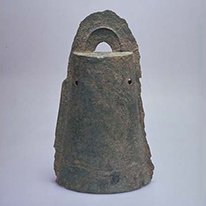Past Exhibitions
- Bronzes of the Yayoi Period
- June 17, 2017 - September 3, 2017
It was during the Yayoi period (c. 5th or 3rd c. BCE–3rd c. CE), about two millennia ago, that the techniques to work metals such as iron and bronze were transmitted from continental Asia to the Japanese islands. Iron was used for tools, farming implements, and weapons, but the majority of bronze pieces produced in Japan at the time were used as ritual implements. Small bells that hung from the necks of livestock on the continent were copied in much enlarged forms in Japan and rung during agricultural rites. Later these dōtaku evolved into even larger bell-shaped bronzes no longer used to produce sound but with strong visual significance. Also from this time we find artifacts resembling weapons, such as bronze swords, halberds, and dagger-axes. Although such implements may initially have been functional, they later seem to have lost their cutting edges—like dōtaku, becoming purely symbolic ceramonial items. Nothing like these Yayoi bronzes was produced during the subsequent Kofun period (ca. 3rd c.–7th c.), presumably due to significant changes in society. This exhibition features Yayoi period bronze artifacts including ritual dōtaku bells and weapons.












